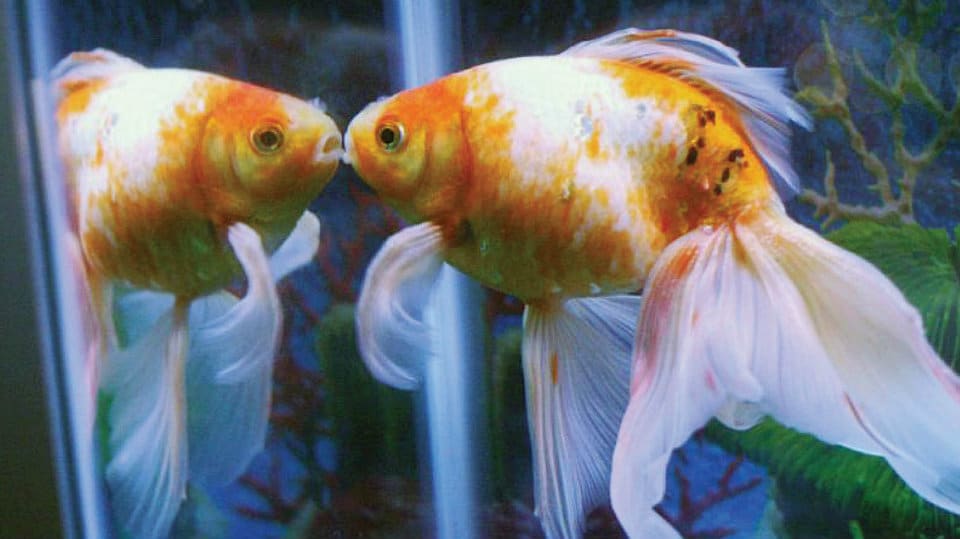In this week’s Pet Talk, Maneka talks about turtles, their habitat & compatibility with fish
By Maneka Gandhi
What kind of an aquarium can I provide my turtle?
It’s NOT your turtle. You are in illegal possession and I suggest that you make every effort to release it before someone tips off the wildlife authorities in your area. They require a habitat with plenty of clean water for swimming, as well as dry land where they can rest, hide and bask in the sun. A tank that can hold at least 40 gallons should give your pet turtle an adequate amount of room to move around in. Both terrestrial and aquatic turtles need to bask.
They need 80% water and 20% land. Make sure they get submerged fully in water and have the luxury to swim around. You’ll need a basking area with UVB lights, if the enclosure is not getting direct sunlight, they need at least 8 hours of sunlight and 12 hours maximum.
Appropriate ambient temperature management is essential. So, provide ambient temperature of 26 to 30 degree Celsius. Regular change of water should be done, otherwise fungal and bacterial disease will flare up, which is common in turtles.
Water depth should be at least 1.5 times the length of the turtle shell. Photoperiod of 12-12 hours should be maintained. (12 hours day and 12 hours night).
In order to reduce selective feeding, offer food blended together in mixtures. Various ingredients can be mixed like vitamins, minerals. Don’t feed oxalate rich stuffs like spinach, cabbage and beet greens as it will lead to hypothyroidism (hormonal disorder). They require high cholesterol content in their diet for proper metabolism. So, provide cholesterol-rich food in the diet.
Encourage natural foraging and the use of wild picked weeds and grasses. Other pet food, like dog food, cat food, are unsuitable for turtles.
Can I house the turtle along with fish in my aquarium?
Turtles are not compatible with fishes, as they will try to hunt the fishes. Certain sizes and types of fishes are never safe in the same tank with a turtle. For example, guppies and goldfishes are never compatible with turtles. Putting such fishes along with a turtle will create a total disaster. But why do you want to create so much stress for fish.
Another important thing to consider when keeping turtles and fishes together is the space. Turtles can grow very large when they are adult. A typical water turtle, like red-eared slider, can reach 10 to 12 inches long. So, you need to keep in mind that if the tank is too small, it will create territorial problems among the turtle and fishes. So, if you are planning to keep turtles and fishes together, try to go for at least an 100-gallon tank.
Apart from extra space, provide plentiful hiding spots and visual barriers, and ensure that all captives are very well fed. Always use a very large habitat when keeping multiple animals together, irrespective of the species involved. Whereas a single red ear slider may thrive in a 55- or 75-gallon habitat, two turtles should have at least 100 gallons of space, and 200 would be much better. The extra space keeps the animals from being forced into constant contact, which can cause stress. Additionally, it’s important to break up the cage with various hiding spots and visual barriers so a submissive animal can escape a dominant one.
Can turtles survive in filthy tanks? How can I clean the tank?
Red-eared sliders and other aquatic turtles spend a lot of time in the water, so clean water is essential. Turtles also defecate in their water, so maintaining good water quality can be a challenge. Cloudy and smelly water in a turtle tank is a common problem, but even water that looks clean can harbour waste products, such as ammonia and nitrites, that can build up to harmful levels. Maintaining good water quality is an important aspect of keeping turtles healthy. As waste products in the tank break down, ammonia is formed, which is potentially toxic and can be dangerous to turtles even at low levels.
Water quality and cleanliness are easier to maintain in a larger tank. In a smaller amount of water, the waste products are more concentrated. With a larger tank, waste matter and its by-products are diluted. In a larger tank, partial water changes are more practical for maintaining consistent water quality, rather than having to change a large proportion (or all) of the water in a smaller tank. A general guideline often quoted is 10 gallons per inch of turtle. There are several options for filters, Choose a filter rated for two to three times the size of your turtle tank. For instance, if you have a 20-gallon tank, choose a filter rated for 60 gallons, even if the tank is not full. Filters with several different levels for removing waste matter as well as by-products are recommended (mechanical, biological and chemical filtration).
Regularly take out part of the water and replace it with fresh water. This removes and dilutes waste products. The frequency of partial changes, and how much water you need to change out, will vary depending on factors, including the size of the turtles, the size of the tank, the filter, and whether you feed in the tank. Frequent partial water changes (weekly or perhaps two to three times a week if necessary) will do. Turtles have lungs and breathe air like people do, so some keepers don’t bother aerating their tanks to put air in the water. But aeration helps keep the water healthy by discouraging the growth of anaerobic bacteria. An aquarium air pump and an air stone will help keep your turtle’s water cleaner.
One way to reduce the amount of waste you need to manage in the tank is to feed your turtle in a separate container. Try a plastic tub. Using water from the tank is an easy way to make sure the temperature of the water is warm enough; just replace the water taken out for feeding with fresh water (and you’ve done a partial water change at each feeding). This eliminates the problem of excess food decaying in the tank, and turtles often go to the bathroom shortly after eating, so the amount of turtle waste accumulating in the tank is reduced as well. Then you can just clean and sanitise the lightweight feeding container after each feeding. But all this is temporary until the turtle is released.
What should I feed the turtle?
Turtles are generally omnivores, eating a mixed diet that includes:
Protein: Feed turtles crickets, meal-worms, wax-worms or fish a few times a week. Place insects on the land area of the habitat, not in the water.
Vegetables: Three or four times a week, serve 1 to 2 teaspoons of dark, leafy greens such as kale, collards or mustard greens. Remove any greens they don’t eat within four hours.
Commercial turtle food: Turtles also like canned turtle food, turtle pellets and frozen or freeze-dried fish food.
Start turtles on about a quarter-cup of food daily and adjust the portion according to how quickly they eat it.
Tortoises like a variety of plant-based foods.
Produce: About 80% of your pet tortoise’s daily diet should be fresh vegetables like kale, dandelions and collard greens. For fun, toss in a little green or yellow bell pepper, sweet potato, squash or cauliflower. It’s good to provide powdered Calcium and Vitamin D3 to the salad around three times a week, which strengthen a tortoise’s shell.
Fruit: Apples, melon and grapes should make up no more than 20% of a tortoise’s diet. Offer your tortoise fruit every third or fourth feeding.
Other: Tortoises also like Timothy and alfalfa hay and commercial tortoise food.
Vitamins & supplements: Calcium is important for both turtles and tortoises. Dust your pet’s food with a Calcium powder twice a week.








Recent Comments